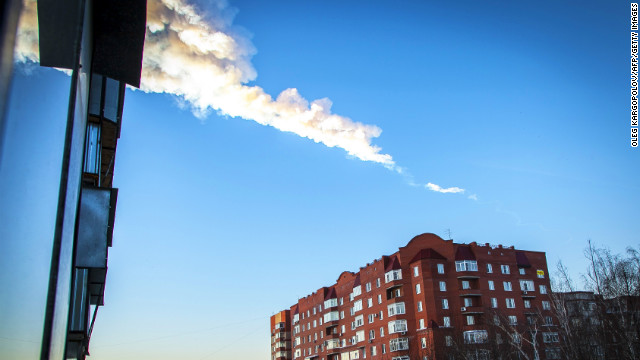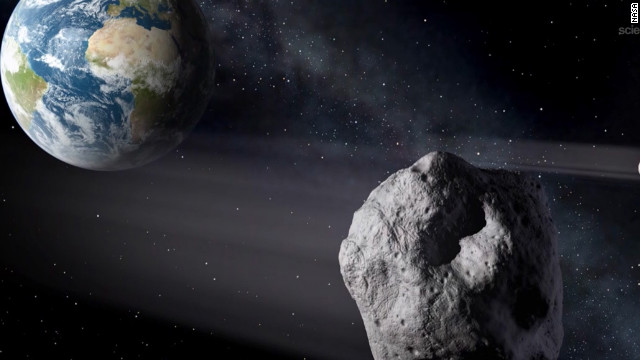STORY HIGHLIGHTS
- NEW: About 1,000 people have reported injuries, state news agency reports
- Meteor strike and Friday's asteroid flyby are unrelated, a NASA spokesman says
- A meteoroid entered the atmosphere and shattered into fragments, scientists say
- A bright white flash appeared in the sky for a few seconds, followed by a heavy bang
The number of injured has continued to rise through the day as new reports come in from across a swath of central Russia.
As of late afternoon
local time, the Interior Ministry said about 1,000 people had been hurt,
including more than 200 children, the state-run RIA Novosti news agency
said.
Most of those hurt are in
the Chelyabinsk region, the news agency said. The vast majority of
injuries are not thought to be serious.
 Photos: Meteor hits Russian region
Photos: Meteor hits Russian region
About 3,000 buildings
have sustained damage -- mostly broken glass -- as a result of the shock
waves caused by the blast, the news agency reported.
Vladimir Stepanov, of the
National Center for Emergency Situations at the Russian Interior
Ministry, earlier told state media that hospitals, kindergartens and
schools were among those affected.
About 20,000 emergency response workers have been mobilized, RIA Novosti reported.
Amateur video footage
showed a bright white streak moving rapidly across the sky, before
exploding with an even brighter flash and a deafening bang.
The explosion occurred about 9:20 a.m. local time, as many people were out and about.
CNN iReporter and Instagram user Max Chuykov saw the meteor trail from the city of Yekaterinburg. He shared on Instagram that it was "close to the ground."
Witness Ekaterina Shlygina posted to CNN iReport and wrote on Instagram: "Upon Chelyabinsk a huge fireball has exploded. It wasn't an aircraft."
The national space
agency, Roscosmos, said scientists believed one meteoroid had entered
the atmosphere, where it burned and disintegrated into fragments,
according to RIA Novosti.
The resulting meteorites
are believed to be scattered across three regions of Russia, one of
them Chelyabinsk, as well as neighboring Kazakhstan, the news agency
said.
One large chunk was discovered in a lake in the Chelyabinsk region, RIA Novosti cited the Chelyabinsk governor as saying.
A spokesman for the
Emergency Ministry for the Chelyabinsk region told CNN earlier Friday
that 524 people there were injured and 34 hospitalized. V4, 2012, CIAT Terms of Use
For sky watchers, the
reports bring to mind the famous Tunguska event of 1908 in remote
Siberia, in which an asteroid entered the atmosphere and exploded,
leveling trees over an area of 820 square miles -- about two-thirds the
size of Rhode Island.
About 80 million trees were felled, radiating out from the center of the blast, but no crater was left.
Friday's Chelyabinsk meteor comes on the same day that a hefty asteroid is due to charge past Earth at a pretty close range, in space terms.
Known as 2012 DA14, the asteroid is thought to be 45 meters long, about half the length of a football field.
But scientists say it will come no closer than 17,100 miles from our planet's surface.
 Photos: All about asteroids
Photos: All about asteroids
"No Earth impact is possible," according to Don Yeomans, manager of the Near-Earth Object Program Office at NASA's Jet Propulsion Laboratory.
Those in Eastern Europe,
Asia or Australia will get the best telescope-aided view, scientists
said. The asteroid won't be visible to the naked eye.
NASA spokesman Steve
Cole told CNN that scientists had determined that the Russian meteor was
on a very different trajectory from the asteroid.
"They are completely unrelated objects -- it's a strange coincidence they are happening at the same time," he said.
"This kind of object
does fall fairly frequently, but when they fall into the ocean or
desert, there is no impact on people -- so this one is unusual in the
sense that it's come over a populated area."
Cole said he wasn't aware if scientists had foreseen the meteor's entry into the atmosphere.
Because meteoroids are
smaller than asteroids or comets, they are hard to spot and there is
often little warning that they are heading toward Earth, he said.
Colin Stuart, an
astronomer at the Royal Observatory in London, said the asteroid's flyby
Friday was a chance for experts to get an unusually close-up look and
learn more.
"Scientists are going to
fire radar beams off of the asteroid, trying to get an idea what it's
made of and the how it's moving, so that in the future, if there's
something that's a bit more of a threat to us, we have the best
knowledge of what we are dealing with," Stuart said.
The asteroid, which is
not connected to the Russian meteor, is not expected to hit any of the
communications satellites it will pass on its trajectory, he said.